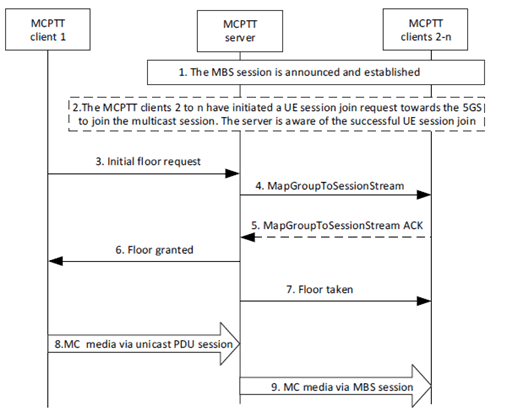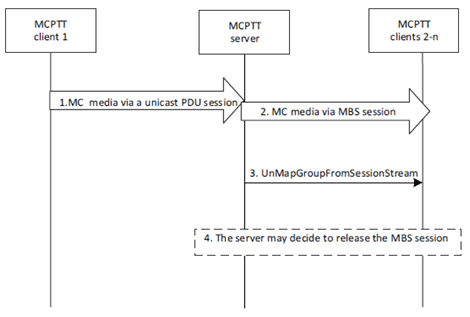Content for TS 23.289 Word version: 19.0.0
0…
4…
4.7…
4.7.4…
4.8…
5…
5.4…
6…
6.3…
6.3.2…
7…
7.2.4…
7.3…
7.3.3…
7.3.3.2…
7.3.3.4…
7.3.3.5…
7.3.3.7…
7.3.3.8…
7.3.3.9…
7.3.3.10…
7.3.3.11…
7.3.3.12…
7.3.3.13…
7.4…
7.5…
7.6…
A…
7.3.3.10 MBS transmission in MCPTT
7.3.3.10.1 General
7.3.3.10.2 Call connect and disconnect over MBS session procedures
7.3.3.10.2.1 General
7.3.3.10.2.2 Procedure
7.3.3.10.2.2.1 Group call connect over MBS session
7.3.3.10.2.2.2 Group call disconnect from MBS session
7.3.3.10.3 Enhanced MCPTT group call setup procedure with 5MBS
7.3.3.10.4 Downlink media transmission with 5MBS
7.3.3.10.5 Switching between 5G MBS session, 5G unicast PDU session, LTE eMBMS bearer, and LTE unicast bearer for MCPTT
...
...
7.3.3.10 MBS transmission in MCPTT p. 90
7.3.3.10.1 General p. 90
MCPTT server can determine to use 5G MBS for the transmission of downlink media for different types of MCPTT group calls.
The application layer signalling such as the floor control messages, application layer paging messages may be transmitted along with the MC media over the same MBS session however with different QoS requirements, or over other means such as unicast downlink or a different MBS session.
When using the procedures for pre-configured or dynamic MBS session establishment for MCPTT, the MCPTT server performs the procedure of call connect and disconnect over MBS session at the group communication session establishment phase.
7.3.3.10.2 Call connect and disconnect over MBS session procedures p. 90
7.3.3.10.2.1 General p. 90
MBS session can be used for MCPTT group calls. One MBS session may be not permanently associated to one specific group or group call.
The procedure in clause 7.3.3.10.2 requires that the group session is setup before the media transmission starts. This eliminates the need for the receiving clients to continuously use a unicast session. Prior to this, the MBS session is activated and announced to the MCPTT clients.
7.3.3.10.2.2 Procedure p. 90
Pre-conditions:
- The MCPTT clients 1 to n are attached to the 5GS, registered and affiliated to the same MCPTT group X.
- The MCPTT server has directly performed (or via NEF/MBSF) an MB-SMF discovery and selection, unless the corresponding information is locally configured.
- The MCPTT server has decided to use an MBS session for the MCPTT service group call associated with to the MCPTT group X.

Figure 7.3.3.10.2.2.1-1: Group call connect over broadcast and multicast MBS sessions.
(⇒ copy of original 3GPP image)
(⇒ copy of original 3GPP image)
Step 1.
An MBS session is configured with the required QoS requirements announced and established.
Step 2.
In the case of multicast MBS sessions, the MCPTT UE initiates a UE session join towards the 5GS, based on the session information provided to the MCPTT UE during the session announcement step. This step is essential in order to receive the corresponding MC media. The multicast MBS session is hence established once the first initiated UE session join is accepted as indicated in TS 23.247.
Step 3.
MCPTT client 1 initiates a group call by sending an initial floor request over a unicast PDU session towards the MCPTT server.
Step 4.
The MCPTT server sends a MapGroupToSessionStream including the necessary stream information for the MCPTT clients 2 to n to receive the MC media related to the group call which is taken place within the associated MBS session.
Step 5.
The MCPTT clients 2 to n process the MapGroupToSessionStream information and may send a MapGroupToSessionStream Ack back to the MCPTT server if required.
Step 6.
The MCPTT server grants MCPTT client 1 the right to transmit media over the associated MBS session and sends a floor granted message to client 1 over a unicast PDU session.
Step 7.
A floor taken message is sent from the MCPTT server to MCPTT clients 2 to n indicating the MCPTT ID of the transmitting client, i.e., MCPTT client 1 and the associated MCPTT group ID. The floor taken message is transmitted over the associated MBS session.
Step 8.
MCPTT client 1 sends the MC media over uplink unicast PDU session towards the MCPTT server.
Step 9.
The MCPTT server sends the MC media over the indicated stream within the associated MBS session to the MCPTT clients 2 to n.
Figure 7.3.3.10.2.2.2-1 presents the procedure for a group communication call disconnect over broadcast and multicast MBS sessions.

Figure 7.3.3.10.2.2.2-1: Group call disconnect over broadcast and multicast MBS sessions.
(⇒ copy of original 3GPP image)
(⇒ copy of original 3GPP image)
Step 1.
The MC group communication is taking place over the associated MBS session. MCPTT client 1 is sending the MC media over a unicast PDU session to the MCPTT server.
Step 2.
The MCPTT server sends the MC media over the associated MBS session to MCPTT clients 2 to n.
Step 3.
After the MC media transmission is over, i.e., no further media to be sent over the group communication, the MCPTT server sends an UnMapGroupFromSessionStream to de-associate the group call from the MBS session.
Step 4.
The MCPTT server may release the MBS session as described in clause 7.3.3.3.2.
7.3.3.10.3 Enhanced MCPTT group call setup procedure with 5MBS p. 92
Enhanced MCPTT group call setup procedure with eMBMS bearer is specified in clause 10.10.6 of TS 23.379. When using mission critical services over 5G MBS, the application paging message transported over 5G MBS session should also be supported.
The related procedures and information flow is as specified in TS 23.379, with only difference of using of 5G MBS session for the transmission of application paging message.
7.3.3.10.4 Downlink media transmission with 5MBS p. 92
The MCPTT service shall support the procedure for using pre-created MBS session, or dynamic MBS session as specified clause 7.3.3.1.
MCPTT may use MBS session for the different types of MCPTT group calls. Both pre-arranged group calls and chat group calls can use the pre-created 5G MBS session for distributing the media.
Both the media packets as well as the floor control messages to the receiving users are sent on the 5G MBS session. Optionally a separate 5G MBS session could be used for the floor control messages.
7.3.3.10.5 Switching between 5G MBS session, 5G unicast PDU session, LTE eMBMS bearer, and LTE unicast bearer for MCPTT p. 92
The MCPTT service shall support the procedure for switching between 5G MBS session, 5G unicast PDU session, LTE eMBMS bearer and LTE unicast bearer as specified in clause 7.3.3.8 and clause 7.3.3.9 with the following clarifications:
- The MC service client is the MCPTT client;
- The MC service server is the MCPTT server; and
- The MC service ID is the MCPTT ID.